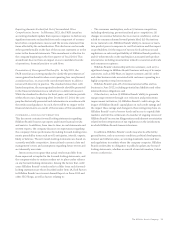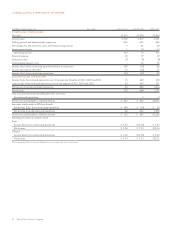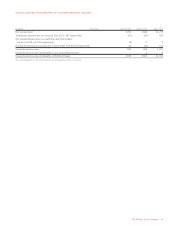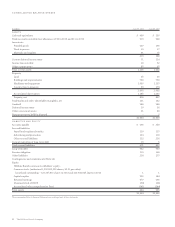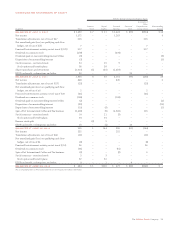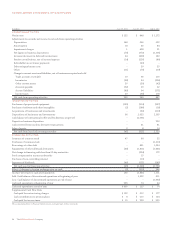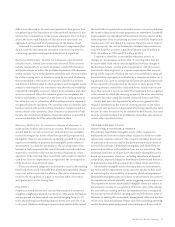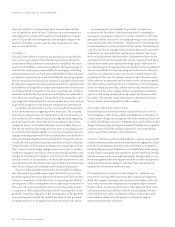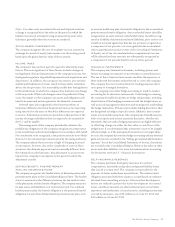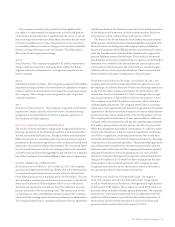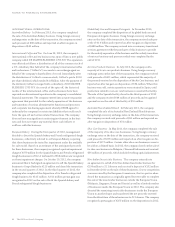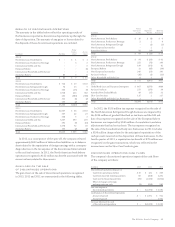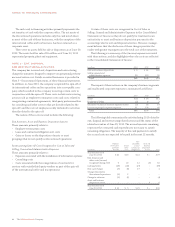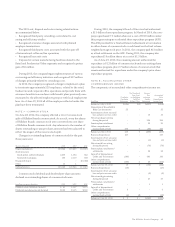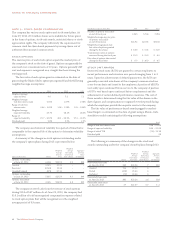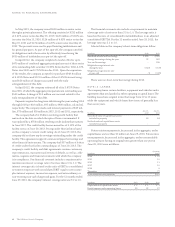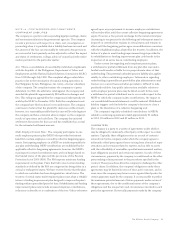Sara Lee 2013 Annual Report Download - page 41
Download and view the complete annual report
Please find page 41 of the 2013 Sara Lee annual report below. You can navigate through the pages in the report by either clicking on the pages listed below, or by using the keyword search tool below to find specific information within the annual report.The Hillshire Brands Company 39
Other For other costs associated with exit and disposal activities,
a charge is recognized at its fair value in the period in which the
liability is incurred, estimated using an expected present value
technique, generally when the services are rendered.
STOCK-BASED COMPENSATION
The company recognizes the cost of employee services received in
exchange for awards of equity instruments over the vesting period
based upon the grant date fair value of those awards.
INCOME TAXES
The company’s tax rate from period to period is affected by many
factors. The most significant of these factors includes changes in
tax legislation, the tax characteristics of the company’s income, the
timing and recognition of goodwill impairments and acquisitions and
dispositions. In addition, the company’s tax returns are routinely
audited and finalization of issues raised in these audits sometimes
affects the tax provision. It is reasonably possible that tax legislation
in the jurisdictions in which the company does business may change
in future periods. While such changes cannot be predicted, if they
occur, the impact on the company’s tax assets and obligations will
need to be measured and recognized in the financial statements.
Deferred taxes are recognized for the future tax effects of
temporary differences between financial and income tax reporting
using tax rates for the years in which the differences are expected
to reverse. Federal income taxes are provided on that portion of the
income of foreign subsidiaries that are expected to be remitted to
the U.S. and be taxable.
The management of the company periodically estimates the
probable tax obligations of the company using historical experience
in tax jurisdictions and informed judgments in accordance with GAAP.
For a tax benefit to be recognized, a tax position must be more-likely-
than-not to be sustained upon examination by the taxing authority.
The company adjusts these reserves in light of changing facts and
circumstances; however, due to the complexity of some of these
situations, the ultimate payment may be materially different from
the estimated recorded amounts. Any adjustment to a tax reserve
impacts the company’s tax expense in the period in which the
adjustment is made.
DEFINED BENEFIT, POSTRETIREMENT
AND LIFE-INSURANCE PLANS
The company recognizes the funded status of defined pension and
postretirement plans in the Consolidated Balance Sheet. The funded
status is measured as the difference between the fair market value
of the plan assets and the benefit obligation. The company measures
its plan assets and liabilities as of its fiscal year end. For a defined
benefit pension plan, the benefit obligation is the projected benefit
obligation; for any other defined benefit postretirement plan, such
as a retiree health care plan, the benefit obligation is the accumulated
postretirement benefit obligation. Any overfunded status should be
recognized as an asset and any underfunded status should be recog-
nized as a liability. Any transitional asset/(liability), prior service cost
(credit) or actuarial (gain)/loss that has not yet been recognized as
a component of net periodic cost is recognized in the accumulated
other comprehensive income section of the Consolidated Statements
of Equity, net of tax. Accumulated other comprehensive income
will be adjusted as these amounts are subsequently recognized as
a component of net periodic benefit costs in future periods.
FINANCIAL INSTRUMENTS
The company uses financial instruments, including options and
futures to manage its exposures to movements in commodity prices.
The use of these financial instruments modifies the exposure of
these risks with the intent to reduce the risk or cost to the company.
The company does not use derivatives for trading purposes and is
not a party to leveraged derivatives.
The company uses either hedge accounting or mark-to-market
accounting for its derivative instruments. Under hedge accounting,
the company formally documents its hedge relationships, including
identification of the hedging instruments and the hedged items, as
well as its risk management objectives and strategies for undertaking
the hedge transaction. This process includes linking derivatives that
are designated as hedges of specific assets, liabilities, firm commit-
ments or forecasted transactions. The company also formally assesses,
both at inception and at least quarterly thereafter, whether the
derivatives that are used in hedging transactions are highly effective
in offsetting changes in either the fair value or cash flows of the
hedged item. If it is determined that a derivative ceases to be a highly
effective hedge, or if the anticipated transaction is no longer likely
to occur, the company discontinues hedge accounting and any deferred
gains or losses are recorded in the “Selling, general and administrative
expenses” line in the Consolidated Statements of Income. Derivatives
are recorded in the Consolidated Balance Sheets at fair value in other
assets and other liabilities. For more information about accounting
for derivatives see Note 15 – Financial Instruments.
SELF-INSURANCE RESERVES
The company purchases third-party insurance for workers’
compensation, automobile and product and general liability claims
that exceed a certain level. The company is responsible for the
payment of claims under these insured limits. The undiscounted
obligation associated with these claims is accrued based on estimates
obtained from consulting actuaries. Historical loss development
factors are utilized to project the future development of incurred
losses, and these amounts are adjusted based upon actual claim
experience and settlements. Accrued reserves, excluding any amounts
covered by insurance, were $32 million as of June 29, 2013 and
$41 million as of June 30, 2012.


